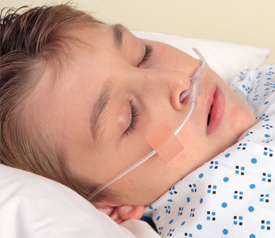
Parents of infants and small children who need supplemental oxygen therapy face many challenges. Perhaps the most difficult challenge is how to keep the nasal cannula (oxygen tube) in its proper place on a wiggly body with grabby hands. The solution is medical tape—but the choice of tape matters.
How do I give oxygen therapy to a small child in my home?
Depending on your child’s needs, you may receive an oxygen tank, and oxygen concentrator, or even a liquid oxygen system. Be sure to have your child’s physician, nurse, or oxygen supplier show you how to properly use the device you are given. Oxygen therapy is a medical treatment, just like an antibiotic, a steroid or a nebulizer breathing treatment. The percentage of oxygen (e.g. 21% or 30%) and the flow rate of oxygen matter.
Face mask or nasal cannula?
Oxygen will be administered through a face mask or, more often, a nasal cannula. A face mask covers the child’s mouth and nose completely and is held in place with an elastic band. While a face mask can be useful for very small infants, it tends to be scary for toddlers. Once a child is hold enough to rip off a face mask, it is probably time to consider a nasal cannula instead.
A nasal cannula is a thin tube that has two small vents that rest just within each nostril. While the nasal cannula may be a little uncomfortable for kids at first, it doesn’t cover the child’s face and isn’t nearly as scary. Moreover, if the nasal cannula tubes are properly taped to the child’s skin, they cannot be easily pulled off. Within a few minutes, the child gets used to the nasal cannula and the oxygen keeps flowing.
How do I secure a nasal cannula to my child?
For infants and very young children, the goal is to tape the tube to the face strategically. A few strips of tape to the cheeks in layers should do the trick. If the child manages to remove one layer, another layer still holds the tube in place. Gently tighten the tube so that it snugly fits around the child’s head. Remember, the medical tape is holding the nasal cannula in place, not the tube around the head. When you pull back on the nasal cannula near the nose, the vents should stay in the nostrils. Use a little extra tape closer to the nose if you need to.
In toddlers and older children, some psychology and buy in may be needed in addition to clever taping. Many children find it comforting to see the nasal cannula put on a stuffed animal, a doll, an older sibling, or mom and dad before they agree to wear it themselves. If you do decide to use a plush animal, make sure not to use tape or to remove the tape out of sight of the child. Remember to praise your child for using oxygen properly.
Read: Tips for Securing the Cannula in Infants and Children
Choosing the right medical tape for oxygen therapy
Most children have delicate skin. The younger the child, the more delicate their skin is. When choosing a medical tape for pediatric oxygen therapy, parents should look for:
- A tape the holds securely
- A tape that does not become too aggressive (i.e. one that does not adhere too tightly to delicate skin)
- A tape that comes off easily
- A tape that comes off cleanly
- A tape that resists secretions and soiling
- A tape with a non-irritating adhesive
- A tape and that are latex-free
Since many children who need oxygen therapy have spent more than their share of time in a hospital setting, using latex-free products is important so that the baby is less likely to develop a latex allergy.
Hy-Tape is the best choice for pediatric oxygen therapy
While there are many types of medical tape, Hy-Tape has several unique properties that make it the best choice for little ones who need oxygen therapy. Hy-Tape or as it is widely known, pink tape, is latex-free. It has a zinc oxide-based adhesive that is soothing to skin. Pink tape is the right combination of “strong hold” and “easy release.” Hy-Tape conforms to skin and is difficult for tiny fingers to remove; however, when it comes time for mom or dad to change tape, Hy-Tape comes of cleanly and easily. There is little to no messy residue, and minimal risk of skin trauma or take burns—even on delicate, baby skin.
The key to Hy-Tape’s unique balance of hold and release is that it holds best at body temperature. Most tapes (e.g. acrylic) become too aggressive for young skin at higher body temperatures. While these tapes will certainly hold the nasal cannula firmly in place, tape changing time becomes an ordeal, leaving the skin raw and irritated.
Lastly, Hy-Tape is occlusive, waterproof, and washable. Pink tape will hold up against drool and sweat and cleans up with warm water, even on the messiest of eaters.
Try Hy-Tape risk-free
Many healthcare providers will send parents home from the hospital with a supply of Hy-Tape to secure their child’s nasal cannula. If you did not get a supply of Hy-Tape during your visit or simply want to try Hy-tape for yourself, we would be happy to send you a sample. When you are ready to buy, we make purchasing and shipping fast, easy, and secure.
Learn More about Hy-Tape and Safely Securing Tubes and Devices
- Nasal Cannula Securement for Seniors, Infants, Toddlers, & Small Children
- Tube Securement for Preemies & Babies
- Skin Tears & Securing Devices On Geriatric & Neonatal Patients
- Preventing Skin Injuries When Securing Endotracheal Tube
- Managing Insulin Pump and Insulin Pod Adhesive Allergy
- Exercising with an Insulin Pump or Glucose Monitor
- Neonatal Skin and Wound Care: Preventing Skin Injury

